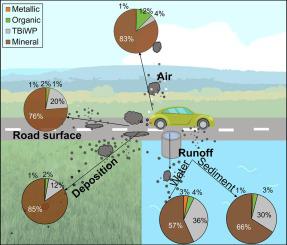Environment International ( IF 11.8 ) Pub Date : 2022-11-03 , DOI: 10.1016/j.envint.2022.107618 Ida Järlskog 1 , David Jaramillo-Vogel 2 , Juanita Rausch 2 , Mats Gustafsson 3 , Ann-Margret Strömvall 4 , Yvonne Andersson-Sköld 1

|
Tire wear particles (TWP) are assumed to be one of the major sources of microplastic pollution to the environment. However, many of the previously published studies are based on theoretical estimations rather than field measurements. To increase the knowledge regarding actual environmental concentrations, samples were collected and analyzed from different matrices in a rural highway environment to characterize and quantify TWP and other traffic-derived non-exhaust particles. The sampled matrices included road dust (from kerb and in-between wheeltracks), runoff (water and sediment), and air. In addition, airborne deposition was determined in a transect with increasing distance from the road. Two sieved size fractions (2–20 µm and 20–125 µm) were analyzed by automated Scanning Electron Microscopy/Energy Dispersive X-ray spectroscopy (SEM/EDX) single particle analysis and classified with a machine learning algorithm into the following subclasses: TWP, bitumen wear particles (BiWP), road markings, reflecting glass beads, metals, minerals, and biogenic/organic particles. The relative particle number concentrations (%) showed that the runoff contained the highest proportion of TWP (up to 38 %). The share of TWP in kerb samples tended to be higher than BiWP. However, a seasonal increase of BiWP was observed in coarse (20–125 µm) kerb samples during winter, most likely reflecting studded tire use. The concentration of the particle subclasses within airborne PM80-1 decreases with increasing distance from the road, evidencing road traffic as the main emission source. The results confirm that road dust and the surrounding environment contain traffic-derived microplastics in both size fractions. The finer fraction (2–20 µm) dominated (by mass, volume, and number) in all sample matrices. These particles have a high potential to be transported in water and air far away from the source and can contribute to the inhalable particle fraction (PM10) in air. This highlights the importance of including also finer particle fractions in future investigations.
中文翻译:

道路环境中轮胎磨损微塑料和其他交通衍生的非尾气颗粒的浓度
轮胎磨损颗粒 (TWP) 被认为是环境微塑料污染的主要来源之一。然而,许多先前发表的研究都是基于理论估计而不是现场测量。为了增加对实际环境浓度的了解,从乡村公路环境中的不同基质中收集和分析样本,以表征和量化 TWP 和其他交通衍生的非排放颗粒。采样矩阵包括道路灰尘(来自路缘和轮轨之间)、径流(水和沉积物)和空气。此外,随着离道路距离的增加,在横断面上确定了空气中的沉积物。通过自动扫描电子显微镜/能量色散 X 射线光谱 (SEM/EDX) 单粒子分析对两个筛分粒度级分(2–20 µm 和 20–125 µm)进行分析,并使用机器学习算法将其分为以下子类:TWP 、沥青磨损颗粒 (BiWP)、道路标记、反光玻璃珠、金属、矿物和生物/有机颗粒。相对粒子数浓度 (%) 表明径流中 TWP 的比例最高(高达 38%)。TWP 在路缘样本中的份额往往高于 BiWP。然而,在冬季粗糙的 (20–125 µm) 路缘样品中观察到 BiWP 的季节性增加,这很可能反映了镶钉轮胎的使用。空气中 PM 中粒子子类的浓度 相对粒子数浓度 (%) 表明径流中 TWP 的比例最高(高达 38%)。TWP 在路缘样本中的份额往往高于 BiWP。然而,在冬季粗糙的 (20–125 µm) 路缘样品中观察到 BiWP 的季节性增加,这很可能反映了镶钉轮胎的使用。空气中 PM 中粒子子类的浓度 相对粒子数浓度 (%) 表明径流中 TWP 的比例最高(高达 38%)。TWP 在路缘样本中的份额往往高于 BiWP。然而,在冬季粗糙的 (20–125 µm) 路缘样品中观察到 BiWP 的季节性增加,这很可能反映了镶钉轮胎的使用。空气中 PM 中粒子子类的浓度80-1随着与道路距离的增加而降低,证明道路交通是主要排放源。结果证实,道路灰尘和周围环境都含有两种尺寸的来自交通的微塑料。在所有样品基质中,较细的部分 (2–20 µm) 占主导地位(按质量、体积和数量)。这些颗粒在远离源头的水和空气中具有很高的传输潜力,并且会影响空气中的可吸入颗粒分数 (PM 10 )。这突出了在未来研究中也包括更细颗粒部分的重要性。


























 京公网安备 11010802027423号
京公网安备 11010802027423号